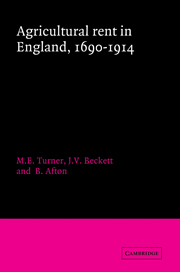Book contents
- Frontmatter
- Contents
- List of figures
- List of tables
- Preface
- Note on the text
- List of abbreviations
- Two examples of contemporary rent books
- Introduction
- 1 Agricultural rent in England
- 2 Contemporary views of rent in eighteenth and nineteenth-century England
- 3 The current state of knowledge
- 4 The determining parameters of a rent index
- 5 Constructing the rent index I: estate records
- 6 Constructing the rent index II: government inquiries
- 7 Constructing the rent index III: other studies
- 8 An English agricultural rent index, 1690–1914
- 9 Rent arrears and regional variations
- 10 The rent index and agricultural history I: the long term
- 11 The rent index and agricultural history II: the short term
- Conclusion
- Appendix 1 Sources of the rent index
- Appendix 2 Statistical summary
- Bibliography
- Index
8 - An English agricultural rent index, 1690–1914
Published online by Cambridge University Press: 02 December 2009
- Frontmatter
- Contents
- List of figures
- List of tables
- Preface
- Note on the text
- List of abbreviations
- Two examples of contemporary rent books
- Introduction
- 1 Agricultural rent in England
- 2 Contemporary views of rent in eighteenth and nineteenth-century England
- 3 The current state of knowledge
- 4 The determining parameters of a rent index
- 5 Constructing the rent index I: estate records
- 6 Constructing the rent index II: government inquiries
- 7 Constructing the rent index III: other studies
- 8 An English agricultural rent index, 1690–1914
- 9 Rent arrears and regional variations
- 10 The rent index and agricultural history I: the long term
- 11 The rent index and agricultural history II: the short term
- Conclusion
- Appendix 1 Sources of the rent index
- Appendix 2 Statistical summary
- Bibliography
- Index
Summary
Despite the problems described in earlier chapters, we have collected a considerable body of data with which to construct a representative index of English agricultural rent. At its greatest extent in the 1880s our database contains material from nearly eighty estates across the country, and over the entire period 1690–1914 we have collected evidence from more than 100 estates (see appendixes). At its maximum, in the third quarter of the nineteenth century, the database includes rents from nearly 1.3 million acres of agricultural land in England. This was a little over 4 per cent of the total land area, but it was upwards of 5.5 per cent of the agricultural area – the area of crops, rotation grass, and permanent grass fluctuated from 23.4 to about 25 million acres according to the June Returns. In this chapter we present our main findings through a series of graphs and tables which provide indexes of rent. At each stage we explain the likely constraints on and limitations of our findings, particularly in the chronological and geographical context. In an ideal world the rents from every estate would be extracted (where they survive) and fed into a database, but we suggest that in the non-ideal conditions under which we have worked the overall results of our work provide a best-possible guide to English agricultural rent between 1690 and 1914. In the second half of the chapter we shall argue, with reference to other estimates, that the index is effectively definitive, and at its most defective it cannot be more than marginally out of true for the greater part of the period.
- Type
- Chapter
- Information
- Agricultural Rent in England, 1690–1914 , pp. 148 - 175Publisher: Cambridge University PressPrint publication year: 1997



